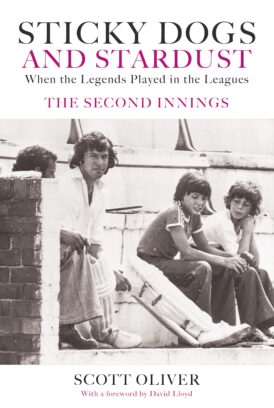Sticky Dogs and Stardust: The Second Innings
Martin Chandler |Published: 2025
Pages: 364
Author: Oliver, Scott
Publisher: Fairfield Books
Rating: 4.5 stars

I knew when I started reading the first innings of Sticky Dogs and Stardust that sooner or later Scott Oliver would produce a follow up, although I have to say I didn’t expect it to appear quite as swiftly as it has, this one being published less than two years later.
I much enjoyed Sticky Dogs and Stardust as, judging by the number of awards it received, did many others. High on its list of plus points was the originality of its mission statement, summed up thus by the author himself:-
No other sport offers up stories quite like the ones collected in these pages. Only cricket – and especially the club cricket of the British Isles – allows recreational players to rub shoulders with international stars and even superstars in a fully competitive context …
It helps too that Oliver can write, and that he has done his research. But I realised as I worked my way through The Second Innings that there is one more unique feature of the book. Those of us entranced by the history of cricket spend our leisure time reading accounts of lives and matches where, almost always, we know what happens at the end of the story.
But that isn’t the case here, something illustrated time and again but never better than in the first chapter, concerning New Zealand Test player Jesse Ryder. I dare say that one day Ryder might produce an autobiography detailing what exactly went wrong with such a promising career. He hasn’t yet though, and if he does I doubt it will give a detailed account of the ups and downs of his summer of 2007, when he was the pro at New Brighton in the Liverpool and District Competition.
The Second Innings, on the other hand, does give a detailed account of a remarkable year in the club’s history and Ryder’s life. In addition the memories of his teammates of Ryder the man do give some clues as to the bigger picture and why his career never scaled the heights that it might have done.
Oliver doesn’t go back too far in The Second Innings, no doubt because his reliance on eye witnesses makes it difficult to cover anything beyond living memory in the way he would like to, but he does go back as far as the early 1960s with a chapter featuring Lance Gibbs and Rohan Kanhai. Both men spent the 1964 and 1965 summers in the North East of England, and their time at other pro gigs is looked at as well. As well as being teammates for British Guiana/Guyana, West Indies and Warwickshire the two had something else in common in that, unusually, their contributions to their employers’ batting (in Gibbs’ case) and bowling (Kanhai) was as insignificant in the North East as it was in the First Class game.
One name I was surprised to see in the chapter listing is that of Mutiah Muralidaran, a man whose name I have never previously spelt like that but, given what I now know, will from now on. I don’t recall it all but a 23 year old Murali spent his summer of 1995 playing for Leicester Ivanhoe. The story of the man who brought him to the club is also an interesting one.
And there are plenty of others, and several joint chapters this time. As well as Kanhai and Gibbs Andy Roberts and Michael Holding share a chapter, and a season, that of 1981 as, a quarter of a century later, did Chris Cairns and Ryan Harris, in both cases in the Lancashire League.
There are other double chapters, one featuring Kim Hughes and Terry Alderman, who both played for Scottish club Watsonians, Morne Morel and Mohammad Asif don’t have a great deal in common, but both played in Staffordshire and three current Australians, Steve Smith Marnus Labuschagne and Travis Head are all looked at together.
Which just leaves Richie Richardson, Abdul Qadir, Joel Garner and Dennis Lillee to make up the thirteen chapters. Some are accounts of the doings of men who were clearly vastly superior to their amateur teammates and opponents, but whilst none of those featured could be described as failures the gulf in class was not always pronounced as the reader might expect, and some of the locals put in some stirring performances of their own.
There might, I suppose, have been a touch of ‘second season syndrome’ about The Second Innings of Sticky Dogs and Stardust, but fortunately there has been no question of that. It would have been easy enough for Oliver to churn out the same old story again and again, but in truth most of the stories he features have at least one aspect to them that sets it apart from the others.
So can we expect a third innings? I certainly hope so, but do wonder if a slight expansion of Oliver’s criteria might be needed. Despite the difficulties in tracking down fresh material might there be men from the 1950s, or even from between the wars who could be featured?
I was also struck in the course The Second Innings by mention of two long serving professionals, Colin Lever and Dik Abed. The brother of the late Peter Lever did manage a single First Class appearance, but Abed none at all, but it certainly sounds like both their career stories, and doubtless others, would be well worth telling.
And why just England? Many young and not so young English professionals have wintered overseas over the years and there must be plenty of interesting stories there too. So even if Oliver might have to think about a slightly different title at some point, I can see this absorbing series of books continuing for many years yet.






Leave a comment